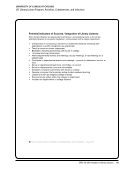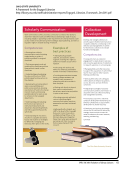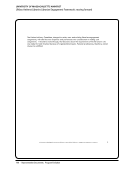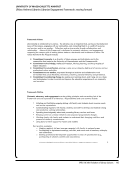70 · Survey Results: Survey Questions and Responses
Constituent groups being served
Disciplinary coordinators/consultative role
Each of these new areas tended to have one or more “champions” among front line liaison librarians, who were seeing
campus needs and became knowledgeable about options.
It is evolving naturally. Recent job descriptions have been updated to reflect these changes.
The decision was made partly based on input from a library-wide strategic planning process.
30. Have liaisons at your library relinquished any responsibilities in order to integrate new ones? N=64
Yes, liaisons have shifted responsibilities 38 59%
Not yet, but there is a plan for this sort of shift in responsibilities to happen over the next 1–3 years 16 25%
No, there is no plan for liaisons to shift any responsibility 10 16%
If yes or you are planning this sort of shift, please briefly describe which liaison roles and
responsibilities have shifted. N=46
As a result of more targeted collection development and patron driven acquisition, some liaisons will be shifting away
from collections work. There will also be greater emphasis put on scholar support rather than on in-person general
library instruction.
Collection development
Collection development responsibilities for liaisons have changed somewhat with the advent of shelf-ready and patron
driven acquisitions. Liaisons still select materials but not to the extent that they once did.
Decrease in desk responsibilities and decrease in first-year instruction
Decreasing reference desk hours, decreasing undergraduate instruction responsibilities
Depending on workloads, some work fewer or more hours on general reference or instruction.
Eliminate reference desk responsibilities.
General reduction in in-house reference services, less emphasis on collection development duties, many fewer formal
classes offered
In general, liaisons are doing less collections work. And we are revamping our instructional program to shift
responsibility for information literacy in introductory courses to a small team of teaching librarians, rather than the
liaisons. This frees up the liaisons to concentrate on integrating research methods into upper level and graduate level
courses, and to work on curriculum mapping to identify other areas for interactions.
In recent years, we have gone to shelf-ready aggressively, reducing the need to review physical books as we have in the
past. In general, we focus more on services and less on collections than we have in previous years.
It is underway, but our biggest challenge has been getting staff to identify and relinquish responsibilities.
Less focus on references, more PDA in collection development freeing up time for deeper liaison connections with
departments in other ways.
Less focus on selection and more focus on education, support, and collaboration.
Constituent groups being served
Disciplinary coordinators/consultative role
Each of these new areas tended to have one or more “champions” among front line liaison librarians, who were seeing
campus needs and became knowledgeable about options.
It is evolving naturally. Recent job descriptions have been updated to reflect these changes.
The decision was made partly based on input from a library-wide strategic planning process.
30. Have liaisons at your library relinquished any responsibilities in order to integrate new ones? N=64
Yes, liaisons have shifted responsibilities 38 59%
Not yet, but there is a plan for this sort of shift in responsibilities to happen over the next 1–3 years 16 25%
No, there is no plan for liaisons to shift any responsibility 10 16%
If yes or you are planning this sort of shift, please briefly describe which liaison roles and
responsibilities have shifted. N=46
As a result of more targeted collection development and patron driven acquisition, some liaisons will be shifting away
from collections work. There will also be greater emphasis put on scholar support rather than on in-person general
library instruction.
Collection development
Collection development responsibilities for liaisons have changed somewhat with the advent of shelf-ready and patron
driven acquisitions. Liaisons still select materials but not to the extent that they once did.
Decrease in desk responsibilities and decrease in first-year instruction
Decreasing reference desk hours, decreasing undergraduate instruction responsibilities
Depending on workloads, some work fewer or more hours on general reference or instruction.
Eliminate reference desk responsibilities.
General reduction in in-house reference services, less emphasis on collection development duties, many fewer formal
classes offered
In general, liaisons are doing less collections work. And we are revamping our instructional program to shift
responsibility for information literacy in introductory courses to a small team of teaching librarians, rather than the
liaisons. This frees up the liaisons to concentrate on integrating research methods into upper level and graduate level
courses, and to work on curriculum mapping to identify other areas for interactions.
In recent years, we have gone to shelf-ready aggressively, reducing the need to review physical books as we have in the
past. In general, we focus more on services and less on collections than we have in previous years.
It is underway, but our biggest challenge has been getting staff to identify and relinquish responsibilities.
Less focus on references, more PDA in collection development freeing up time for deeper liaison connections with
departments in other ways.
Less focus on selection and more focus on education, support, and collaboration.












































































































































































































